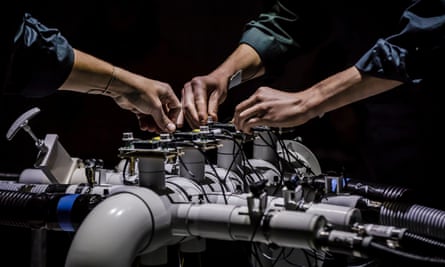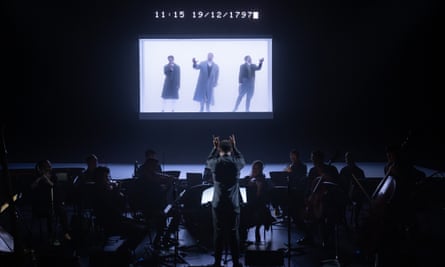The Antarctic – the idea of it, the harsh reality of it – has fascinated humans for centuries. Artists have tried to conjure it. Explorers have tried to conquer it. Scientists and environmentalists are trying to save it.
It’s a fascination we’re unlikely to overcome, librettist Tom Wright says, ahead of the Australian premiere of the new opera Antarctica, composed by Mary Finsterer for the Sydney Chamber Opera. It is one of two works about the great white continent at this year’s Sydney festival: alongside Wright and Finsterer’s avant garde opera is the experimental sound performance Polar Force. Both works attempt to draw audiences into the nature and existential crisis of the polar continent.
“[The Antarctic is] not ours, it’s not for us, and so by way of analogy, it becomes either our hell or our heaven,” says Wright. “The Antarctic represents the limits to our knowledge and our pride. I like the idea of it being like a forbidden garden, a place we shouldn’t exploit, something to remind us that the world is not our oyster.”
In Polar Force, audiences are drawn sonically and thermally into today’s Antarctic. “We’re cooling the space down to 17C, which is roughly what the temperature inside an Antarctic base station is,” says Speak Percussion’s artistic director, Eugene Ughetti, who performs Polar Force with sound artist/designer Philip Samartzis. “Then we slowly allow it to warm up during the performance. You won’t feel uncomfortable in any way, but you will experience climate change over the course of the hour.”
Audiences will enter an inflatable structure, a bit like an igloo, erected in Carriageworks’ Track 12 space, and observe the performers engage in a “sonic dialogue” with field recordings made by Samartzis during his time as a resident artist with the Australian Antarctic Division in 2009-10 and 2015-16.
The performance looks more like laboratory work than traditional music-making. Ughetti and Samartzis play bespoke machines and manipulate compressed air and water. The space is alive with the sounds of thawing permafrost, cracking ice, grinding glaciers.
“Right from the start, I didn’t want to work with conventional musical instruments at all,” explains Ughetti. “They didn’t feel right for capturing a place where everybody is a scientist or a researcher of some kind.”
The resulting sounds can be unfamiliar and unsettling. “Sometimes, moving ice can sound like something that’s alive,” says Ughetti.
There will be recognisable sounds in the mix too – the anthropogenic racket that is the inevitable byproduct of exploration: diesel generators, transport planes, machine tools, trucks and transporters.

“It’s all part of the lived experience of the continent now,” says Ughetti. “That’s the message, I guess. That we can’t experience the Antarctic without having a physical impact on it. The more we want to be there, see it, feel it, the more fingerprints we leave on it.”
That sense of a continent in peril is also present – though less obviously – in Wright and Finsterer’s opera, which occupies Carriageworks’ Bay 17. Antarctica had its world premiere in the Netherlands in 2022; Sydney festival is its Australian premiere.
If Polar Force plugs into the present plight of the southernmost continent, then Antarctica taps into its past – that of a mysterious, semi-mythic place, a tabula rasa destined to become the last frontier of imperial ambition. The story begins with a cartographer discovering an ancient manuscript describing a great southern continent, who then persuades two other scientists to get aboard a ship and find it. Each of the three has their own reason for wishing to voyage into the unknown – about which none of them are being entirely honest.
It’s a story of pride and hubris, Wright explains, “a journeying of the human soul that ends with enveloping ice and snow and glaring light.”
Polar Force is an intimate spectacle, while Antarctica is epic in every sense. Designer Elizabeth Gadsby’s set presents a towering 9-metre-high wall of LED screens pierced by a department-store-sized window, behind which the cast perform as if in a human fish tank. The five singers are like “ghosts in a milk-fog” inside that box, which is filled with a vocally safe haze.
Singer Jane Sheldon says the show is “relentlessly challenging” for the performers. “Normally, we sing in the same acoustic space as the audience so singing the entire show inside this container is really, really strange for us,” she says. “We knew the stage design would be abstract and not realistic. I mean, how do you put Antarctica on stage? Whack a few icebergs on?”
The Dutch contemporary classical ensemble Asko|Schönberg is arranged in full view of the audience. At times, the auditorium is flooded with clouds of coloured light that envelop the senses.

“We try to evoke a big conceptual imaginative seascape through this piece,” says Wright. “There are characters and plot, but we’re also creating a sense of what this enormous nautical and ice-based world without humans is like.”
Human impact on the Antarctic, however, is unlikely to diminish in the near future. According to the International Association of Antarctica Tour Operators , Antarctic tourism is booming. About 100,000 tourists – mostly aboard cruise ships – are expected to visit the shores of Antarctica in 2023, a doubling of the pre-pandemic numbers.
“I talked to a scientist in the Antarctic Division in Hobart and he said the best thing the world could do with Antarctica would be to get out, pack up all of our rubbish and leave it alone,” says Wright. “I think that’s one of the messages of the piece – that there are places we just shouldn’t go. There’s more to this planet than just tourism or mining opportunities. There is something calming and eternal about that.”

